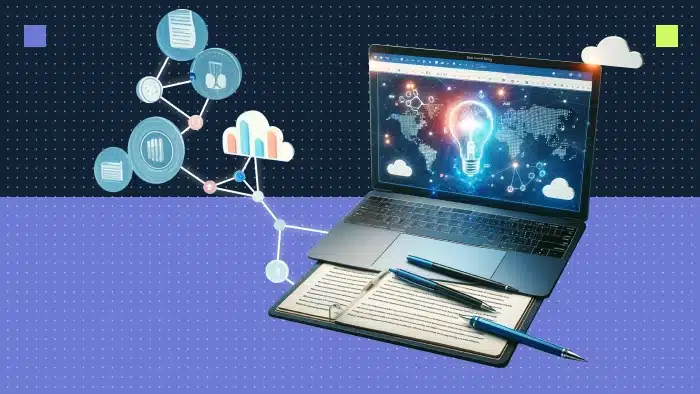How to generate demand with content marketing for cybersecurity companies

Helpful and insightful content is a goldmine for demand generation in the crowded B2B SaaS cybersecurity market. By investing in SEO-driven content marketing, cybersecurity companies drive brand awareness, build thought leadership and win over their competition. I’ll show you how.
Seizing the cybersecurity market opportunity with a demand generation program
Inbound content helps your target audience realize they have a need or want for a specific solution — your solution.
Creating and fostering interest in products and services is exactly what demand generation is about — and the reason why you should be outputting search-optimized content. With demand generation SEO, you:
- Increase your online share of voice, attracting the right person to the right content at the right time of their buyer journey.
- Establish your brand perception as a credible thought leader.
- Enable prospects with detailed and educational resources, showing you do get their pain points — and also have a solution to them.

Standing out from the crowd will allow you to capitalize on a $2 trillion market opportunity characterized by:
- Escalating cyber attack surface and threat landscape with new vulnerabilities and attacks gaining media headlines day after day
- Fierce market competition with new players constantly entering the market
- Increased pressure on business leaders to secure their organizations’ systems, devices and data
As Google Trends shows, there’s a growing search interest for cybersecurity services, especially over the last five years.
B2B buyers seek cybersecurity content that guides them through the sales funnel
In B2B SaaS, the sales cycle is longer, as you have to deal with multiple decision makers and stakeholders with (very often) competing priorities. There are higher stakes (significant investments, business alignment, tech stack integration, employee training etc), requiring a more thorough evaluation.
Yet, Gartner found that a sales rep gets roughly only 5% of a customer’s total purchase time. In contrast, independent research on the internet accounts for 27% of the buying group’s time. That means your personas spend more time consuming online resources than talking with sales teams. And that’s why you want to be found on search engines — so you start building and nurturing a relationship with buyers to tap into what is a lucrative (but competitive) market.
A content marketing program tailored to cybersecurity companies helps you create a pathway for your buyer personas to discover, trust and engage with your brand, ultimately increasing your chances of being the go-to choice when they make that crucial purchasing decision. In fact, for 83% of marketers surveyed by the Content Marketing Institute (CMI), content marketing is the most effective marketing strategy for demand generation efforts, followed by SEO.

The role of SEO in your cybersecurity content marketing strategy
Content is what drives SEO — but not any type of content. If you don’t follow the basics of SEO writing, you won’t get the results you want. Equally important is to offer a smooth, intuitive and engaging user experience.
You might have the most comprehensive content, but if your site is slow, readers will bounce. If you don’t have calls to action (CTAs), you won’t convert.
- Is fast, easy to navigate and mobile-responsive
- Gives you search visibility and engagement
- Drives targeted traffic to relevant pages
- Offers valuable, resonating content
- Increases conversions, turning visitors into sales leads
To understand your marketing return on investment (ROI), look at the opportunities coming from having an optimized website (leads, partnerships). And don’t forget to take into account the impact that building thought leadership content has on brand awareness and perception (e.g., improved visibility, credibility and trust).
In the case of one of our B2B cybersecurity clients, first-touch attribution data shows that, in a period of 18 months, two gated white papers generated seven deal opportunities totaling $3.4M in annual contract value.

SEO content marketing lays the groundwork for demand generation in cybersecurity
For 57% of B2B marketers in the latest annual report from the Content Marketing Institute, creating the right content is their top challenge. To ensure alignment between your audience needs and your marketing resources, you need to conduct keyword research, understand the intent behind each query and output content with SEO in mind.
You also want readers to spend more time on your website, either visiting more resources or even better, contacting your sales team. But you would be surprised by the amount of blog posts and web pages that fail to include CTAs. When leveraging SEO content marketing for cybersecurity demand and lead generation, the basics go a long way. For example:
- Proper keyword placement to enhance your content’s visibility on search engines, ensuring that it reaches your target audience when they actively seek security solutions.
- Increased readability, achieved through short paragraphs and clear sentences, makes your content more user-friendly while aiding in conveying complex cybersecurity concepts more effectively.
- Internal links within your content create a seamless navigation experience for your audience, encouraging them to explore additional resources and reinforcing your brand’s authority.
- Strategically placed CTAs urging readers to book a demo or reach out to the sales team help to convert interest into tangible leads, facilitating a smoother transition through the sales funnel.
B2B content marketing checklist for cybersecurity teams
In order to leverage cybersecurity content marketing to generate demand for your B2B SaaS solution, follow this checklist:
1. Get to know your audience
According to 47% of marketers in a Semrush survey, the number 1 factor leading to content success is to research the targeted audience. So make sure to identify the pain points, challenges and objectives that resonate with your potential clients. Tailor your content to address their specific needs, whether it’s data security, cyber threat intelligence or secure cloud solutions. Review documents such as your ideal customer profile and buyer personas.
→ Download now: ICP template for B2B marketing teams
2. Research your competition
Gain insights into the content strategies employed by your competitors in the cybersecurity space. Understand the topics they cover, the tone they use and the channels through which they distribute their content. Leverage competitive analysis to identify content gaps, allowing you to create unique and compelling material that sets your cybersecurity solution apart.
3. Diversify your content formats
Selecting the right format is crucial to effectively convey your message and engage your audience. Experiment with a combination of formats to create a well-rounded cybersecurity content marketing strategy that resonates with your buyer personas.
When asked about what content type they use for demand generation, 96% of organizations cite blogs. And 95% list videos. But let’s review the main options:
| Type of content | Description |
|---|---|
| Blog posts and FAQs | Informative articles addressing cybersecurity trends, best practices and industry news |
| Video content | Engaging videos covering cybersecurity tips, product demonstrations or interviews with industry experts |
| Case studies | Examples showcasing how cybersecurity solutions have addressed and resolved specific challenges |
| Webinars | Live or recorded online webinars that provide in-depth discussions on specific cybersecurity topics or products |
| White papers and ebooks | In-depth, authoritative reports and guides that delve into complex cybersecurity topics, offering insights and solutions |
| Infographics | Visual representations of data, statistics or processes related to cybersecurity, making information more digestible |
| Podcasts | Audio content discussing cybersecurity trends, threats and strategies, often featuring guest experts |
4. Create authoritative content that offers insights and solves pain points
Position your cybersecurity company as an authority by creating educational and insightful content. Develop resources that delve into current cybersecurity trends, best practices and use cases. This way, you foster thought leadership, building trust and credibility within the cybersecurity industry.
PRO tip: Writing about technology for a specialized audience requires technical precision, storytelling and strategic insights. You need to strike a balance between depth of understanding and clarity. My top tips:
- Use plain language. Avoid fluffy sentences and technical jargon.
- Be precise. For example, a data breach and a leak are not the same thing.
- Provide actionable tips, ensuring that you’re bringing value to your audience.
- Interview subject matter experts to create resonating content.
- Avoid alarmist or sensationalist claims. Instead, back up the information with data.
- Use examples and case studies to make the content relatable.
✏️ Learn how to master B2B SaaS content writing with our actionable tips.
5. Provide social proof
Gartner found that customer reviews and ratings are the top type of content B2B software buyers use to make software purchase decisions. Take advantage of this buying trend by showcasing your results. Collect and highlight reviews, case studies and success stories from satisfied clients who have benefited from your B2B SaaS cybersecurity solution.
6. Build a content calendar that contemplates different stages of the cybersecurity buyer journey
Proactively plan and schedule content to optimize resource allocation. A well-structured content calendar not only ensures a consistent and timely flow of information but also allows for strategic alignment with key moments in the cybersecurity landscape (industry events, trends, product launches).
When building your editorial calendar, leverage keyword research and competitive insights to determine your topics. Plus, make sure you have content targeting the different stages of the marketing and sales funnel. The goals, after all, are different:
- Top of the funnel (TOFU) content (e.g, ebooks and blogs) attracts attention
- Middle of the funnel (MOFU) content (e.g., how-to guides and comparison pages) generates leads
- Bottom of the funnel (BOFU) content (e.g., product briefs and success stories) drives conversions
7. Optimize your content for search engines
Ensure your content is discoverable on search engines. Identify relevant keywords and incorporate them naturally into your blogs and landing pages. Search optimization increases the likelihood of your cybersecurity solutions appearing in the SERPs when potential clients are actively seeking information.
8. Engage on social media
Leverage social media platforms to amplify your content’s reach. Share your blog posts, videos and insights on LinkedIn, Twitter and other relevant channels. Engage with your audience, respond to comments and join discussions to enhance your brand’s online presence.
9. Implement email campaigns
Develop targeted email marketing campaigns to nurture leads and keep your audience informed. Share relevant content, industry updates and exclusive insights to keep your cybersecurity product or service top of mind for potential clients.
10. Measure and iterate your cybersecurity content marketing efforts
Leverage analytics tools to measure the performance of your marketing efforts. Track the top metrics:
- Rankings
- Traffic
- Time on page
- Clickthrough rate
- Demo signups
Use the insights gained from the analytics to refine your cybersecurity content strategy continuously, ensuring it remains effective in generating demand.
Cybersecurity marketing examples to inspire you
Let’s review top examples of content marketing for cybersecurity companies.
1. War pages
Competitor comparison landing pages are dedicated content to showcase your solution in parallel to those of your competitors. By helping potential customers make informed buying decisions, this type of content is a magnet for conversions.
Here’s an example from SaaS Alerts, which includes comparison pages in its content marketing strategy as a way to highlight why it’s the best alternative among its competitors.
2. Survey reports
Data-driven insights showcasing market trends and user surveys help to position your brand as a thought leader. As other industry players reference and link to your findings, it strengthens your online presence and authority.
Here’s an example from Keeper’s survey on password habits, helping to reinforce this company’s expertise in the password management market.
3. Webinars
Hosting webinars on your website is a great way to discuss complex cybersecurity challenges and best practices, show your cybersecurity solution in action and foster engagement among your audience.
In this example from Brinqa, a group of cybersecurity experts discusses the latest developments in vulnerability management.
4. Cornerstone content
Cornerstone content and pillar pages offer comprehensive content on a topic cluster. By providing in-depth knowledge, this type of content establishes your brand as an authority, attracting a steady audience over time and contributing to sustained demand generation.
Here’s an example from Armis’s playbook on IoMT security.
5. Blog posts
Consistently publishing insightful blog posts helps to position your B2B company as a go-to resource, driving demand for your expertise. And yes, people do read blogs.
Just keep in mind that, giving the importance of security to all B2B SaaS products and services, cybersecurity companies are not the only ones blogging about cybersecurity topics.
Here’s an example from the cloud-based content management platform Box, which positions itself as a thought leader in the topic of security vaults.
Partner with a cybersecurity content marketing agency
If you’re looking to enhance your cybersecurity content marketing initiatives, there’s no need to tackle it solo. Internal marketing teams are already juggling numerous responsibilities, from brand promotion to campaign management.
Partnering with a specialized cybersecurity marketing agency like ours, you take your efforts to new heights. You get the help you need to overcome these top content challenges:
- Attracting quality leads with content
- Creating more content faster
- Generating content ideas
You get a dedicated team of digital marketing consultants who bring proven methods to the table. By sharing the workload, your internal team can concentrate on other initiatives, leaving content ideation and writing with us. We do extensive research, interview your SMEs and build an SEO-driven content marketing strategy for your cybersecurity company.
Let’s work together to generate demand for your B2B SaaS solution. Drop us a message.

Vanessa Nunes, PhD
Vanessa Nunes leads the content team at Productive Shop, based in our downtown Toronto office. She oversees our B2B SaaS content strategies across our entire portfolio, ensuring our growing team delivers resonating copy that is optimized for search. Her own expertise is in researching and writing thought leadership content in the cybersecurity and GovTech industries. As a journalist, Vanessa has over a decade of experience covering the tech sector for a leading daily newspaper. Prior to Productive Shop, she worked for a research center at a Canadian university, chairing academic discussions and editing scholarly work for publication. Vanessa's formal training includes an undergraduate degree in Journalism, a master's degree in Cultural Studies and a Ph.D. in English. Her doctoral research — funded by the prestigious Social Sciences and Humanities Research Council of Canada (SSHRC) Fellowship — focused on issues of language and representation in the transnational imaginaries of the Americas. When she's not writing or reading, Vanessa is running, cycling or traveling the world. She has visited over 20 countries and is currently training for her first marathon.










